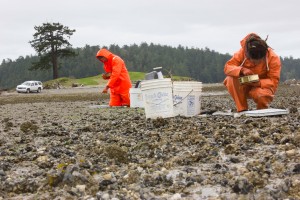
Source: Northwest Indian Fisheries Commission
The Swinomish Tribe is developing a subsistence manila clam fishery on Lone Tree Point.
“We’re using habitat we already have to increase opportunities for our tribal members to gather shellfish,” said Lorraine Loomis, fisheries manager for the tribe. “Shellfish always have been part of our traditional diet and culture.”
In 2011, shellfish biologist Julie Barber seeded five test plots totaling 1,000 square feet with good survival results. Last summer, tribal members and staff seeded an entire acre of varied beach habitat north of the lone tree that gives the beach its name.
“This beach includes areas of desirable habitat such as sand and gravel, as well as areas of mud and fine silt, which is poor manila clam habitat,” said shellfish biologist Julie Barber. “Because the tribe will not be enhancing the poor substrate with gravel, as many commercial growers do, we avoided seeding these areas. Since the 2012 seeding, we have been monitoring survival and growth throughout the seeded area to determine how survival differs along the beach by location and elevation.”
Manila clams are a staple of many tribal shellfish programs because they survive at higher elevations in the intertidal zone than native littleneck clams, and are found in a shallower depth, so they are easier to dig. They reach a harvestable size two or three years after planting.
So far, survival seems to be better on the southern part of the beach, so the tribe plans to concentrate its efforts there. Some of the clams from the 2011 test plots could be harvested as soon as next summer.
